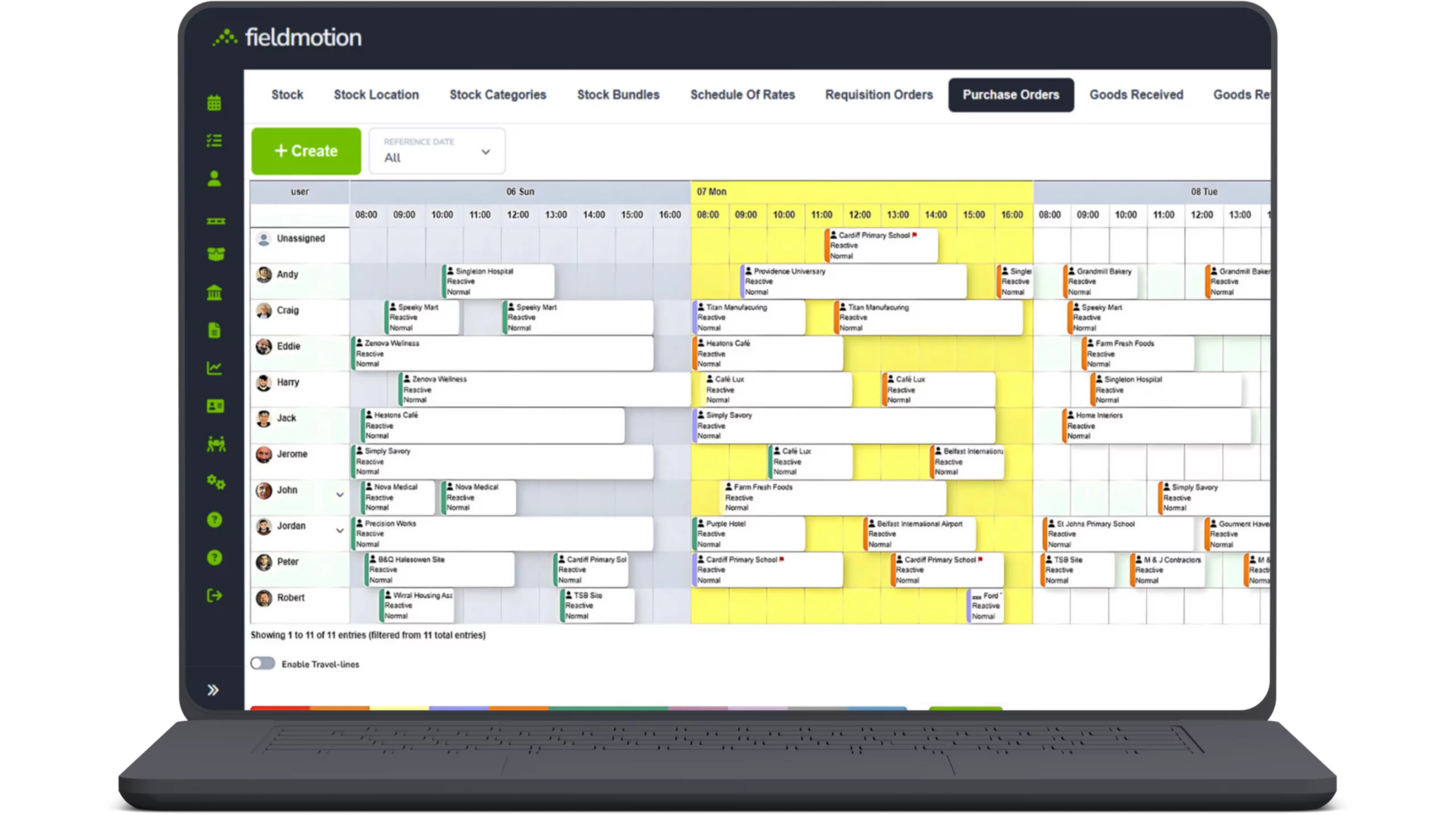Field-service businesses across the UK and Ireland are facing a silent crisis. Customer expectations are rising, margins are tight, and technology is evolving fast — yet the biggest threat to growth is something far more basic: a shortage of skilled people.
Whether you run a plumbing firm in Cork, a facilities-maintenance team in Manchester or an electrical-service company in Belfast, finding and keeping qualified technicians has never been harder. The result? Jobs delayed, overtime bills mounting, customers waiting, and business growth stalling.
This isn’t just a recruitment headache — it’s a strategic risk that touches every part of your operation, from scheduling and job quality to reputation and profitability.
Below, we explore the true scale of the workforce shortage, why field-service firms feel it most, and what practical steps can help you overcome it — including how the right job-management software can ease the pressure.
Here’s what we’ll cover:
- The Scale of the Problem (UK & Ireland)
- Why the issue is particularly acute for field-service companies
- Impact on business performance: what it means in practice
- Solutions & Best Practices for Field-Service Companies
- How Fieldmotion Helps Address the Workforce Challenge
- Next Steps: Audit, Benchmark and Act
The Scale of the Problem (UK & Ireland)
United Kingdom
The figures are stark.
- The Trade Skills Index 2023, produced by About Apprenticeships and the Construction Industry Training Board, estimates the UK will need 937,000 new recruits in the skilled trades within the next decade to meet demand and replace retiring workers (Edge Foundation report).
- According to the Employer Skills Survey 2024, 12 percent of UK employers report internal skills gaps affecting around 1.26 million employees — and 76 percent say they struggle to fill vacancies because of a lack of qualified candidates (Explore Education Statistics).
- The Occupations in Demand 2024 bulletin highlights that nearly 2.8 million workers in shortage occupations, such as electrical fitters and maintenance engineers, are at skill level 3 — precisely where many field-service roles sit (Explore Education Statistics).
Ireland
The picture is no better across the Irish Sea.
- The ManpowerGroup Talent Shortage Report 2025 found that 83 percent of Irish employers are struggling to find skilled talent — one of the highest rates in Europe (Manpower Ireland).
- A Kemmy Business School labour-market review also points to persistent recruitment and retention difficulties in technical sectors, from construction and utilities to maintenance and logistics.
Why This Matters to Field-Service Businesses
Shortages in the wider trades sector directly hit field-service firms because they rely on the same pool of electricians, HVAC technicians, plumbers and maintenance engineers.
When that pool shrinks:
- hiring takes longer and costs more;
- overtime and subcontracting eat into profit;
- and expansion plans are held back for lack of staff capacity.
For owners and operations managers, these statistics aren’t abstract — they show up in everyday pain points: technicians stretched thin, projects delayed, customers waiting longer than promised.

Why the issue is particularly acute for field-service companies
The skilled-labour shortage is felt across every trade, but it hits field-service companies especially hard. Your business depends on mobile engineers who can diagnose, repair, and deliver customer service on-site — often without supervision. When those skills are scarce, the consequences multiply.
1. An ageing workforce and fewer young entrants
A large proportion of qualified engineers and tradespeople are nearing retirement, while too few school-leavers are choosing the trades.
The Trade Skills Index 2023 warns that half of the UK’s qualified tradespeople could retire within ten years unless new entrants rise dramatically (Edge Foundation).
Tip: If you’re considering apprenticeships as part of your recruitment strategy, make sure you understand wage and compliance rules on both sides of the Irish Sea.
Read our companion guide: Apprenticeship Wages in 2025 – What Field Service Employers Need to Know.
2. Competition for the same talent
Field-service firms compete for technicians with construction, manufacturing, utilities and facilities-management employers — all offering similar pay for similar skill sets. Larger organisations may lure candidates with better pensions, fleet vehicles, or career structures.
Smaller and mid-sized service businesses often lose out unless they can differentiate through culture, flexibility, or technology.
3. Limited career pathways in smaller firms
Unlike large enterprises, many field-service companies have flat hierarchies. Without visible progression routes — from apprentice to senior technician to team leader — ambitious staff move elsewhere. Structured training plans and defined roles are key to retaining talent.
4. Operational pressures magnify the strain
Field-service work is reactive, fast-moving and geographically dispersed. When staffing is tight, those pressures quickly show:
- Technician no-shows or sickness create costly rescheduling.
- Urgent call-outs stretch already busy teams.
- Travel inefficiencies waste hours of billable time.
- Rising wage inflation forces you to pay more for fewer people.
The result is longer lead times, reduced responsiveness, and mounting stress on managers and engineers alike.

Impact on business performance: what it means in practice
The workforce crisis is not just a staffing issue; it affects every line on your profit-and-loss statement.
| Challenge | Practical impact on the business |
|---|---|
| Job delays and backlogs | Customers wait longer, satisfaction drops, and you risk losing repeat business. |
| Increased overtime or subcontracting | Costs rise while margins shrink; reactive work becomes unprofitable. |
| Limited capacity to take new contracts | Growth stalls because you physically cannot service more clients. |
| Declining service quality | Stressed teams make more mistakes, resulting in rework and call-backs. |
| Higher wage inflation | Paying premiums for scarce skills erodes competitiveness against more efficient rivals. |
Every inefficiency compounds the next. When technicians are overbooked, response times lengthen. Customer complaints rise. Supervisors spend more time firefighting than planning. Cash-flow tightens as jobs take longer to complete.
Field-service brands live or die by reliability. A single missed appointment or repeated delay can damage trust that took years to build. Word spreads quickly online and within local business networks. Even loyal clients may reconsider if service standards slip.
Many firms find themselves trapped: demand exists, but they can’t scale operations because their existing staff are already stretched. Adding new contracts simply increases overtime and churn — a vicious cycle that limits growth potential.

Solutions & Best Practices for Field-Service Companies
Solving the skills shortage isn’t about a single quick fix. The companies that are thriving despite staff shortages are those taking a multi-layered approach: investing in recruitment, training, retention, and smart technology to make every hour of labour count.
1. Strengthen recruitment and retention
Build apprenticeships into your hiring strategy
Apprentices remain one of the most effective ways to grow your own workforce and protect against long-term shortages. They bring enthusiasm, adaptability, and a willingness to learn your systems from day one.
To succeed, structure apprenticeship programmes properly:
- Partner with local colleges or trade training providers.
- Assign mentors who can guide apprentices through on-site work.
- Offer clear post-qualification roles to keep them motivated.
And importantly, understand the legal and financial side of taking on apprentices. Wage rates, training allowances, and compliance requirements differ between the UK and Ireland.
Related resource: Apprenticeship Wages in 2025 – What Field Service Employers Need to Know
Learn about the current UK & Ireland apprentice pay rates, budgeting examples, and planning checklists.
Create visible career paths
Retention improves when technicians see a future within your company. Map out clear progression routes such as:
- Apprentice → Junior Engineer → Senior Engineer → Supervisor → Operations Manager.
- Recognise milestones through pay reviews, certifications, and new responsibilities.
Promoting internally doesn’t just boost morale — it shows new recruits that loyalty is rewarded.
Improve culture and flexibility
You might not match the salaries of the largest firms, but smaller companies can offer something equally valuable: flexibility, recognition, and genuine teamwork.
Allow technicians some autonomy in scheduling, celebrate great customer feedback, and maintain transparent communication about workloads.
Fieldmotion Brochure
See how Fieldmotion helps field service teams manage jobs, schedule staff, create invoices, and communicate with customers — all from one easy-to-use system.
2. Upskill and multi-skill your workforce
Encouraging technicians to broaden their skill sets helps spread capability across the team.
- Cross-training lets engineers handle a wider range of call-outs, reducing the need for specialist subcontractors.
- Continuous learning ensures staff keep pace with new technologies — whether that’s renewable systems, smart home tech, or IoT-enabled diagnostics.
- Use quieter seasonal periods to run training sessions or refresher workshops.
Digital learning platforms and manufacturer-certified courses make this easier than ever.
3. Boost workforce efficiency through technology
Labour shortages mean every hour of technician time matters. The fastest-growing field-service firms are turning to job-management software to streamline workflows and lift productivity.
Key efficiency gains include:
- Optimised scheduling: automatically assign the right job to the right engineer, factoring in skill set, location, and availability.
- Reduced travel time: route-planning tools cut unnecessary mileage and fuel costs.
- Mobile data capture: technicians complete job reports, photos, and customer sign-offs via app, saving hours of paperwork.
- Fewer admin errors: data syncs instantly with your back office, improving invoicing speed and accuracy.
Even a modest productivity gain — say 10 percent more jobs completed per technician per week — can offset the need for additional hires.
4. Modernise your employer brand
Younger recruits want to work with technology that feels current. Position your business as a digital, mobile, and skilled workplace, not an old-fashioned “clipboard and ladder” operation.
Show prospective employees that you use mobile apps, real-time updates, and automated reporting. Highlight this in job adverts and at interviews — it signals professionalism and efficiency.
5. Build a long-term pipeline
Recruitment shouldn’t stop once roles are filled. Maintain ongoing links with training bodies, apprenticeship providers, and local colleges. Offer work experience or summer placements to students exploring trade careers.
You’ll create awareness of your business and build a future talent pipeline before competitors do.
Quick win: Attend local apprenticeship fairs or partner with Education & Training Boards (in Ireland) to raise your visibility among new entrants.

How Fieldmotion Helps Address the Workforce Challenge
Even with the best recruitment and training initiatives, there will still be times when hiring the right people takes longer than you’d like. That’s why forward-thinking field-service firms are investing in systems that let existing staff do more with less effort.
This is where Fieldmotion’s job-management software makes a measurable difference.
1. Increase utilisation without adding headcount
By improving scheduling, route planning, and real-time visibility, Fieldmotion helps you reclaim wasted technician hours.
- Assign jobs based on skill, proximity, and availability.
- Reduce time spent travelling between sites.
- Fill last-minute gaps with automated reallocation.
When you eliminate these inefficiencies, technicians can complete more jobs each week — effectively expanding your workforce capacity without extra recruitment.
2. Cut administrative burden
Paperwork and manual data entry are silent productivity killers. Fieldmotion digitises the entire workflow:
- Technicians access job details and service history via the mobile app.
- On completion, they capture photos, customer signatures, and parts used — all synced instantly to the office.
- Invoices and reports are generated automatically, reducing turnaround time and human error.
The result: less time on admin, faster invoicing, and happier staff who spend more time doing the work they’re trained for.
3. Improve first-time fix rates
When technicians have accurate, up-to-date job data and asset history at their fingertips, they arrive prepared. Fewer repeat visits mean lower costs and higher customer satisfaction. Over time, that consistency strengthens your reputation and reduces churn.
4. Support remote management and data-driven insight
Fieldmotion gives managers a live view of every technician’s schedule, travel time, and job status.
Dashboards highlight bottlenecks, training needs, or under-utilised staff. With this insight, you can decide whether you truly need more engineers — or whether better allocation and process refinement will achieve the same result.
For example:
- If data shows 25 % of time lost to travel, smarter routing may free up one day per week per technician.
- If certain job types take longer, targeted training or checklists can close the gap.
5. Make your workplace more appealing
Technicians increasingly expect modern, digital tools — not clipboards and paperwork.
When your company uses intuitive mobile technology, it signals professionalism and progress. That can be a deciding factor for younger, tech-savvy recruits choosing between employers.
By giving staff clear visibility, less admin, and more autonomy, you’re also improving retention. Happy technicians stay longer, reducing recruitment pressure further.
6. Link efficiency with recruitment messaging
Your technology story is part of your employer brand.
When prospective apprentices or engineers see that your business uses Fieldmotion to plan jobs, track performance, and communicate seamlessly, it positions you as a forward-thinking company that values efficiency and innovation.
Include this in your job adverts and training-provider outreach:
“We use digital job-management software to make your day easier — less paperwork, smarter scheduling, faster communication.”
That small statement can differentiate you from competitors still relying on manual systems.

Next Steps: Audit, Benchmark and Act
The field-service skills shortage is not going away soon. But with the right approach, your business can stay resilient, competitive, and ready for growth.
Here’s how to start tackling it today:
1. Audit your current workforce
Begin with a straightforward internal review:
- Billable vs. non-billable hours: What percentage of technician time generates revenue? How much is lost to travel, admin, or waiting for parts?
- Scheduling efficiency: Are jobs being allocated based on proximity and skill match?
- Churn rate: What’s your annual staff turnover, and why are people leaving?
- Training and skill coverage: Do you have clear visibility of who can handle which types of jobs?
These data points reveal whether you truly need more staff — or better utilisation of the people you already have.
2. Benchmark your attractiveness to recruits
Think about how your company appears to potential apprentices and engineers. Ask yourself:
- Do we advertise a clear career path and structured progression?
- Are we paying fairly and transparently — in line with national apprentice and technician rates?
- Do we showcase the technology that supports our teams?
3. Review your tools and processes
Ask these diagnostic questions:
- How do we currently manage scheduling and job allocation — manually, or through digital systems?
- Do our technicians use mobile apps for updates and job completion?
- Are we capturing job data that can inform training, process improvements, or route optimisation?
Even small technology gains can produce major workforce relief. For instance, cutting five minutes of admin from ten jobs per day equals over 200 hours of reclaimed time per technician each year.
4. Build your talent pipeline
Treat recruitment as an ongoing process rather than an annual campaign.
- Maintain relationships with local colleges, apprenticeships offices, and trade training providers.
- Attend skills fairs or offer short-term placements




